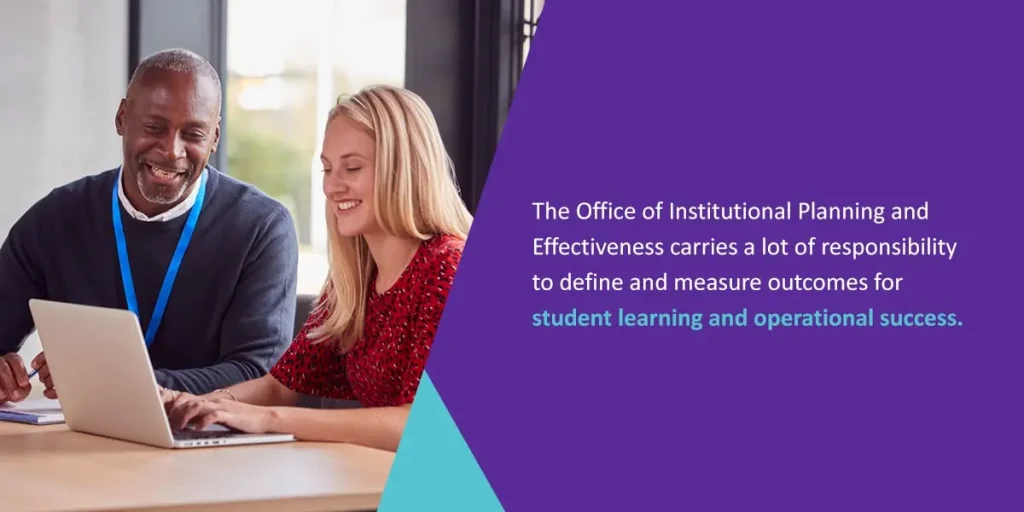




Accreditation can be a complex, confusing process if you aren’t prepared for it. Adjusting your year-round data collection and reporting processes will prepare you for reaccreditation when the time comes.
The Southern Association of Colleges and Schools Commission on Colleges (SACSCOC) is focused on confirming educational quality and improving the effectiveness of its member institutions. The accreditation process is rigorous, so here are a few tips for creating an assessment process to effortlessly demonstrate SACSCOC compliance.
Your institution’s mission statement is more than a rallying cry — it’s the foundation of everything you do for students, faculty, and the community. Include your institution’s values and what it aims to provide. A strong mission statement shows purpose and can set you apart from other institutions.
Beyond inspirational platitudes, your mission statement should clearly state what your institution is working to achieve over the next three, five, or even 10 years. Maintaining a mission statement with actionable goals your institution intends to work towards shows accreditation agencies the thought and dedication put into improvement. A mission statement also helps institutions stay on track to reach goals and can guide future decisions.
Achieving accreditation is easier with a clearly defined mission statement in place. By keeping your school’s mission top of mind, you can clearly document how outcomes assessments relate to the mission and ensure that campus-wide goals are aligned.
What your faculty does and achieves impacts the institution, its students, and your overall success. Highlighting and documenting faculty accomplishments can help your institution meet accreditation requirements. For example, well-qualified facility members and professors are crucial to creating and maintaining high-quality academic programs. SACSCOC requires accredited institutions to maintain documentation of faculty qualifications and related accomplishments or experience.
Faculty activity reporting supports multiple purposes including annual review, promotion, and tenure decisions — but the qualifications and accomplishments you track can also demonstrate how your institution’s faculty are working to support the mission. For example, alternative qualifications can reinforce a faculty member’s experience level with a specific topic.
By creating a consistent data set for all faculty at your institution, you’ll be ready to report on and justify faculty accomplishments that support SACSCOC requirements.
One of the biggest factors accrediting agencies like the SACSCOC focus on is student success. What is your institution doing to improve student success specifically? Creating a quality enhancement plan (QEP) shows the SACSCOC that your institution has identified issues related to student success rates and how you plan to address those topics over the coming years. A plan for student success shows specific actions your institution will take to see more students succeed.
Prioritizing student success makes an institution more desirable for students and faculty, leading to higher success overall.

The Office of Institutional Planning and Effectiveness carries a lot of responsibility to define and measure outcomes for student learning and operational success. The data from this office helps drive informed decision-making on campus and can be used in accreditation reporting to support assertions and reinforce your school’s commitment to continuous improvement.
Continuous improvement is essential to accreditation for several reasons. For example, your institution may need to improve to meet initial accreditation requirements or maintain accreditation status. Improvement goals also show the SACSCOC that your institution continuously aims to provide students and faculty with the best education and environment possible.
Measuring and documenting the success of such improvements is also necessary for reaching accreditation. When it comes time to furnish detailed reports that support ongoing improvement efforts for accreditation, having a complete set of data that aligns with your school’s overarching strategic plan is essential.
While saying you can do all these things is great, the SACSCOC requires assessments and documentation to prove you’re doing what you say you can or will do. Keeping your measurements and documentation organized and consistent helps your institution effectively use the collected data and information and makes it easier for the accreditation agency to understand.
A combination of direct and indirect measurements is the backbone of a well-rounded academic assessment strategy. Successful accreditation reporting requires demonstrating both tangible proof of student learning, such as exam scores, and subjective measures, like survey and evaluation responses. Together, these measurements provide the full picture of your institution’s performance.
By collecting a broad range of data for assessment and accreditation reporting, you’ll address SACSCOC requirements and provide actionable insights to internal and external stakeholders.
Getting accredited requires significant amounts of documentation, and going paperless is one of the most effective ways to organize and share the necessary assessments. For example, recording and storing all your institution’s data in centralized accreditation software makes it easy to access and generate necessary reports.
This is also beneficial when an accreditation committee or faculty group has been assigned to the accreditation process, as multiple people can upload information for others to see and use. The right software can also help you track your institution’s goals and provide actionable insights regarding growth and improvement. Additionally, digitized documentation is much easier to submit for SACSCOC requirements.

Watermark’s solutions are designed to simplify the accreditation process, offering pre-built templates and strategic integrations that pull together direct and indirect measurements for easy analysis. Our solutions help you gather, use, and share actionable insights to create meaningful practices and support continuous improvement. While accreditation is a complex process, our software helps centralize everything you need to ensure your institution is prepared.
For more advice on preparing for your next accreditation review, download The Essential Guide to SACSCOC Accreditation.






























































































































































































































































































































































































Submit this form to schedule a meeting with one of our reps to learn more about our solutions. If you need customer support instead, click here.